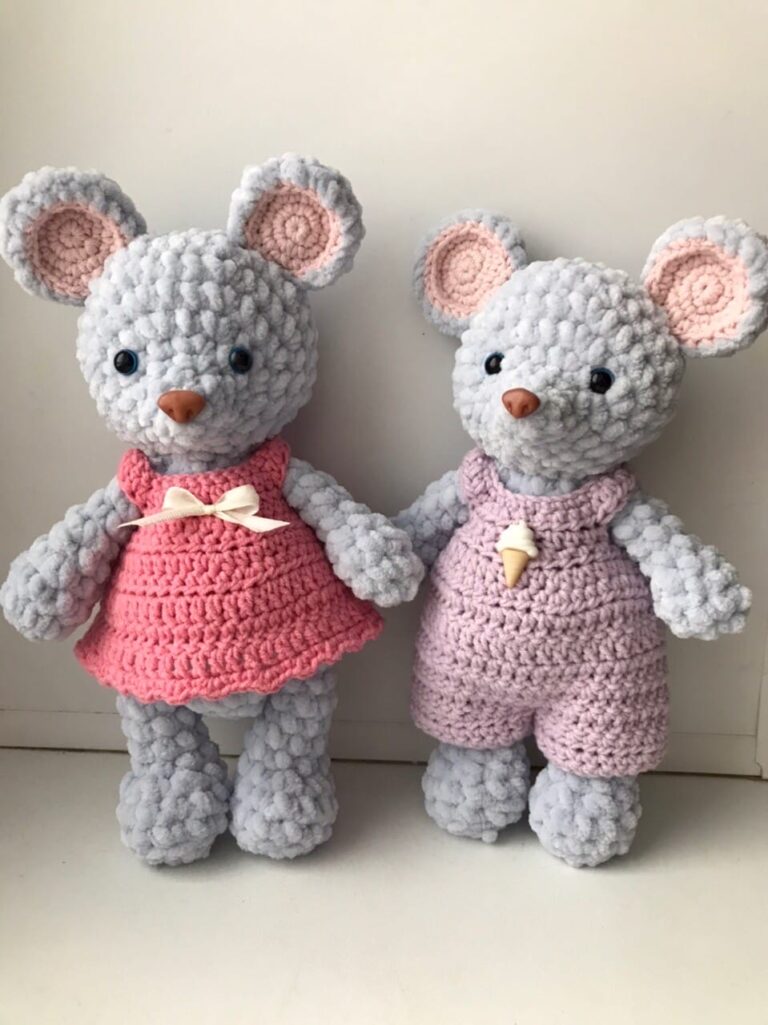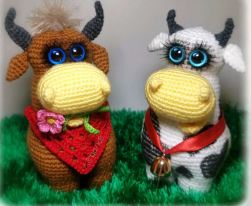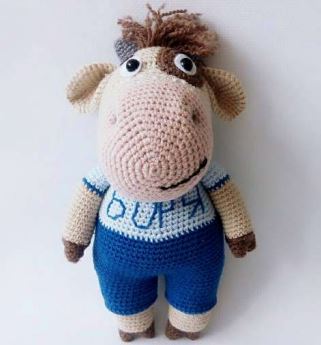Amigurumi Hello Kitty Free Pattern
Amigurumi Hello Kitty Free Hello dear Amigurumi FollowersToday we share one free amigurumi crochet pattern again for you. Amigurumi Hello Kitty Free As you know we share new amigurumi free patterns every day. Hello Kitty Free Pattern
Amigurumi Hello Kitty Free
Materials and tools
– Yarn Art Jeans
No. 03 – milky (the main color for Kitty).
Additional colors and the type of wings differ depending on the outfit of the toy. In this master class, knitting is demonstrated using the example of a butterfly outfit. Choose one main color and one/several additional colors for the suit Amigurumi Hello Kitty Free
For Butterfly:
No. 89 – light purple
No. 72 – lilac.
For Ladybug:
No. 26 – red;
No. 53 – black.
For Bee:
No. 35 – yellow;
No. 70 – chocolate;
No. 88 – light yellow.
– Black floss threads for face decoration;
-Strong cotton thread (for example, “Iris”) for attaching handles;
– Markers for knitting;
– Filler for toys (holofiber);
– Hook number 2;
– Sewing pins;
– Needle with a wide eye, as well as a thin sewing needle;
-Oval half beads of black color for the eye (8*10 mm) and yellow for the spout (6*8 mm) / pieces of felt of the corresponding colors and sizes or sewing threads for embroidery of the eye and spout;
-Scissors;
– A small piece of wire for the antennae.
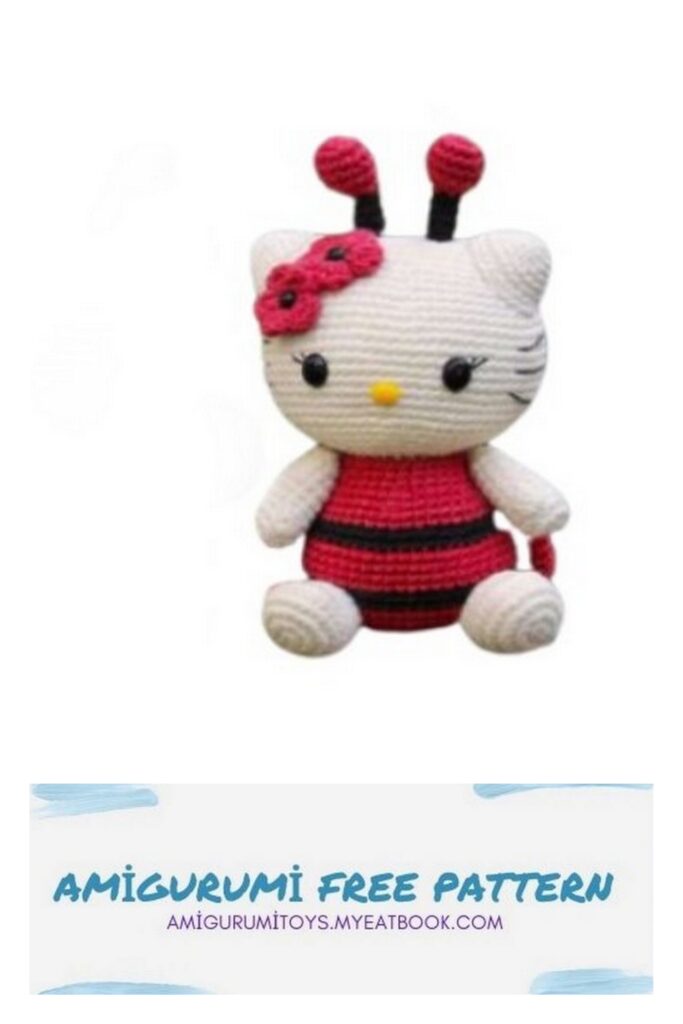
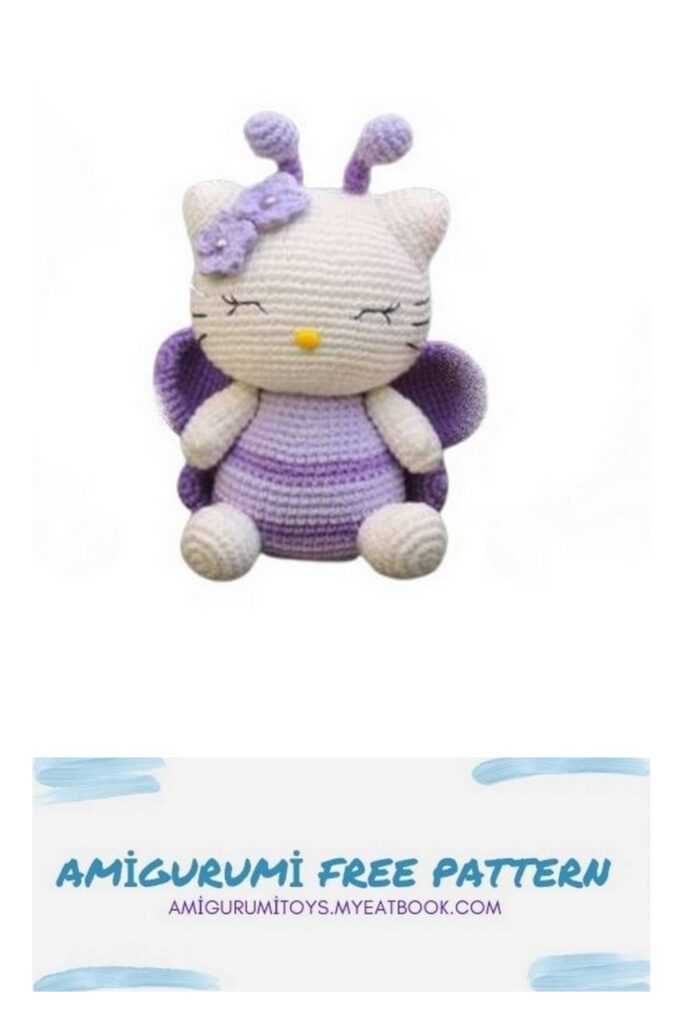

Conventions
MR – amigurumi ring
SC – single crochet
İNC – increase (two columns knitted in one loop)
DEC – decrease (two columns knitted together)
SL-ST – connecting post
HDC – half double crochet
DC – double crochet
CH – air loop
ps – lush column (4 DC with a common top, knitted in one loop)
(…) * n – repeat the specified in brackets n times)
(…) – the numbers in brackets indicate the final number of loops in the row
Amigurumi Hello Kitty Notes
All parts of the toy are knitted in a spiral without connecting posts between rows and lifting loops. Use a marker for easy row counting.
When using these materials, the toy is about 12 cm in height, not counting the antennae.
You can use any other yarn that matches the texture and color.
Choose a hook suitable for the thickness of the thread and your knitting density.
Handles (x2)
1 row: 6 SC in MR (6)
2 row: 6 İNC (12)
3rd row: 12 SC (12)
4 row: 6 SC, 1 ps, 5 SC (12)
5 – 10 row: 12 SC (12)
Stuff the handles, fill less tightly towards the end.
11 row: 6 DEC (6)
Pull and cut the thread, leaving a small tail. Using a needle, pull off the hole by passing the thread through the front half loops of the last row. Hide the end of the thread inside the part.
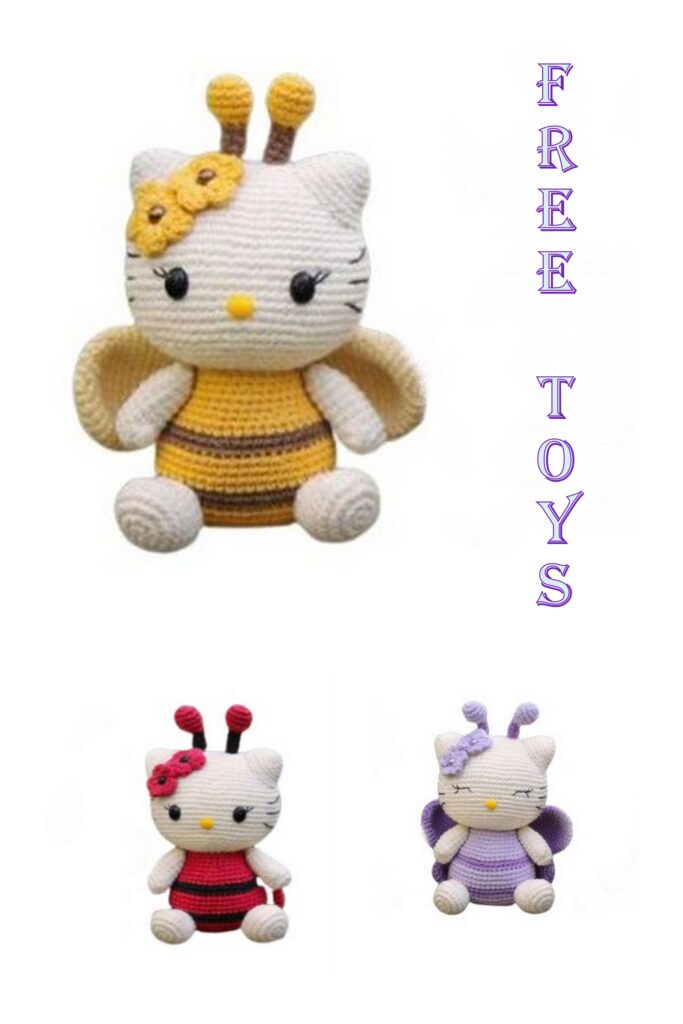
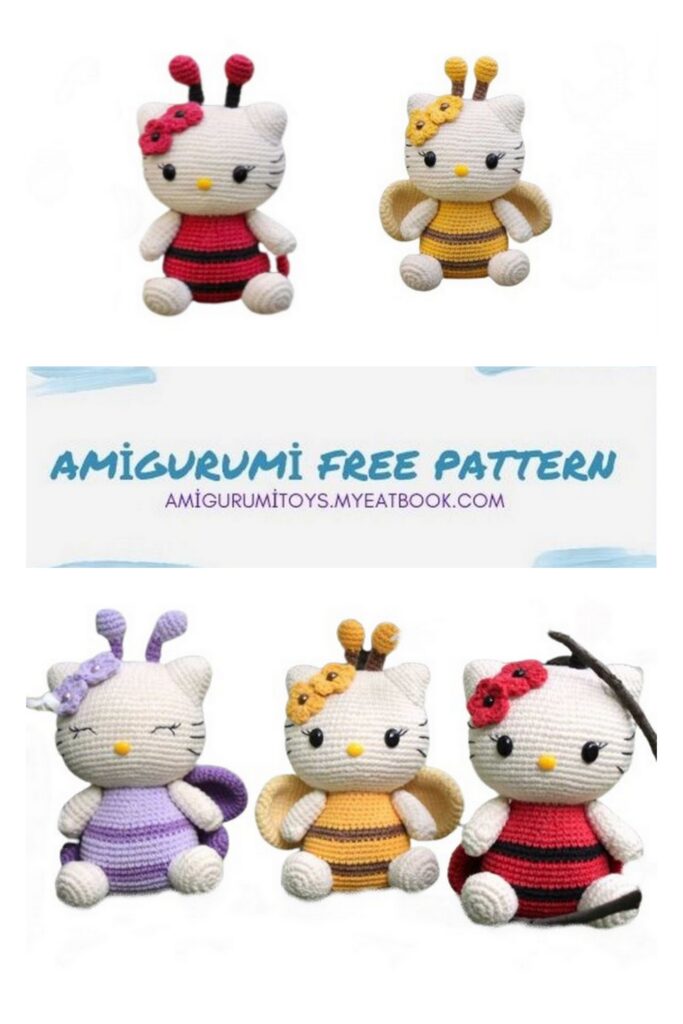
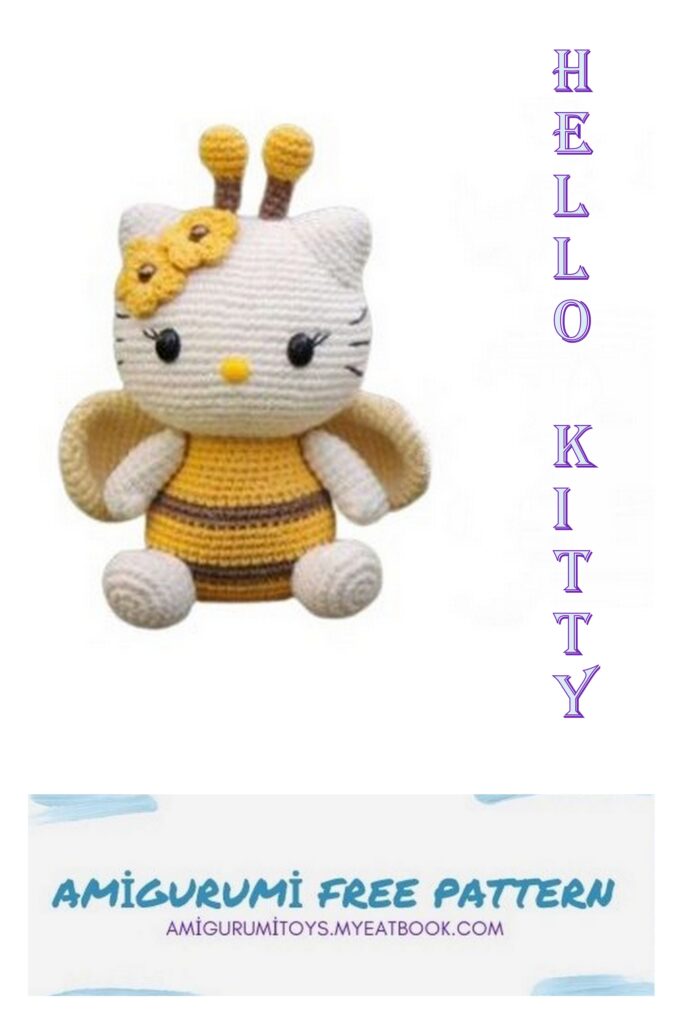
Legs (x2)
1 row: 8 SC in MR (8)
2 row: 8 İNC (16)
3 row: (1 SC, İNC) * 8 (24)
4 – 6 row: 24 SC (24)
7 row: 8 SC, 4 DEC, 8 SC (20)
8 row: 8 SC, 2 DEC, 8 SC (18)
9 row: 18 SC (18)
Pull and cut the thread, leaving the tail for sewing.
Get a leg.
Ears (x2)
1 row: 6 SC in MR (6)
2 row: (1 SC, İNC) * 3 (9)
3 row: (2 SC, İNC) * 3 (12)
4 row: (3 SC, İNC) * 3 (15)
5 row: (4 SC, İNC) * 3 (18)
6 row: (5 SC, İNC) * 3 (21)
7 row: 3 SC, İNC, (6 SC, İNC) * 2.3 SC (24)
Pull and cut the thread, leaving the tail for sewing.
Stuff your ears.
Tail
1 row: 6 SC in MR (6)
2 row: 6 İNC (12)
3 – 5 row: 12 SC (12)
Pull and cut the thread, leaving the tail for sewing.
Stuff the ponytail.
Flowers (x2)
1 row: 5 SC in MR (5)
Change the thread to a contrasting one, the previous one can be cut off.
2 row: (SL-ST, HDC, 3 DC, HDC) * 5 (30)
Pull and cut the thread, leaving the tail for sewing.
Antennae (x2)
1 row: 6 SC in MR (6)
2 row: 6 İNC (12)
3 – 5 row: 12 SC (12)
6th row: 6 DEC (6)
Stuff the detail. Change the color to contrast.
7 – 10 row: 6 SC (6)
Pull and cut the thread, leaving the tail for sewing.
For stability, insert a piece of wire inside the base of the antennae.
Tolova
Cast on a chain of 14 CH, knit from the 2nd loop from the hook:
Row 1: İNC, 11 SC, 2 İNC in last st, other side of chain: 11 SC, İNC(30)
2 row: 2 İNC, 11 SC, 3 İNC, 13 SC, İNC (36)
3rd row: İNC, 1 SC, İNC, 13 SC, İNC, 1 SC, İNC, 1 SC, İNC, 13 SC, İNC, 1 SC (42)
4th row: 42 SC (42)
5 row: 1 SC, İNC, 2 SC, İNC, 14 SC, İNC,
2 SC, İNC, 2 SC, İNC, 14 SC, İNC, 1 SC (48)
6 row: 48 SC (48)
7 row: (7 SC, İNC) * 6 (54)
8 row: 54 SC (54)
9 row: (8 SC, İNC) * 6 (60)
10 row: 60 SC (60)
11 row: (9 SC, İNC) * 6 (66)
12 – 20 row: 66 SC (66)
21 row: (9 SC, DEC) * 6 (60)
22 row: 1 SC, DEC, (8 SC, DEC) *5, 7 SC (54)
23 row: (7SC, DEC) * 6 (48)
24 row: 1 SC, DEC, (6 SC, DEC) * 5, 5 SC (42)
25 row: (5 SC, DEC) * 6 (36)
26 row: 1 SC, DEC, (4 SC, DEC) *5, 3 SC (30)
Bring the thread to the beginning of the 27th row, where we left the marker.
Start filling in the part.
27 row: (3 SC, DEC) * 6 (24)
Mark the beginning of the 27th row with a marker!
28 row: 1 SC, DEC, (2 SC, DEC) * 5, 1 SC (18)
29 row: (1 SC, DEC) * 6 (12)
30 row: 6 DEC (6)
Add filler, evenly distribute it inside the part.
Pull and cut the thread, leaving a long end for sewing. Pinch off the hole with a needle.


body
Cast on a chain of 15 CH, knit from the 2nd loop from the hook:
1 row: İNC, 12 SC, 2 İNC in the last loop, on the other side of the chain: 12 SC, İNC (32)
2 row: 2 İNC, 12 SC, 4 İNC, 12 SC, 2 İNC (40)
3 row: (İNC, 1 SC) * 2, 12 SC, (İNC, 1 SC) * 4,
12 SC, (İNC, 1 SC) * 2 (48)
4 – 6 row: 48 SC (48)
Without cutting the main thread, attach the yarn of a contrasting color and knit the next 2 rows with it.
7 – 8 row: 48 SC (48)
We change the thread again and knit with the main color next 4 rows.
9 – 12 row: 48 SC (48)
We knit the next 2 rows in a contrasting color.
13 row: 48 SC (48)
14 row: (6 SC, DEC) * 6 (42)
The thread of the additional color can be cut, now we knit only the main one.
15 – 16 row: 42 SC (42)
17 row: (5 SC, DEC) * 6 (36)
18 row: 36 SC (36)
19 row: (4 SC, DEC) * 6 (30)
20 – 21 row: 30 SC (30)
Work an additional 2 SC so that the row ends exactly on the side of the body. Pull and cut the thread, hide the tail inside the part and stuff the body tightly.
Wings for a bee and a ladybug (x2)
1 row: 6 SC in MR (6)
2 row: 6 İNC (12)
3 row: (1 SC, İNC) * 6 (18)
4 row: (2 SC, İNC) * 6 (24)
5 row: (3 SC, İNC) * 6 (30)
6 – 9 row: 30 SC (30)
10 row: (13 SC, DEC) * 2 (28)
11 row: (12 SC, DEC) * 2 (26)
12 row: (11 SC, DEC) * 2 (24)
13 row: (10 SC, DEC) * 2 (22)
14 row: (9 SC, DEC) * 2 (20)
15 row: (8 SC, DEC) * 2 (18)
16 row: (7 SC, DEC) * 2 (16)
17 row: (6 SC, DEC) * 2 (14)
Work 2 extra SC to even out the row, fold the piece in half and work 7 SC, picking up both ends of the piece. Pull and cut the thread, leaving the tail for sewing. The item does not need to be filled in.
Ladybug spots (x4)
Row 1: 6 SC in MR, SL-ST (6)
Pull and cut the thread, leaving a long end for sewing. Symmetrically arrange the spots on both wings and sew.
Butterfly wings (x2)
The butterfly wing consists of an upper and lower part, which are then combined into one.
Lower part of the wing
(part #1):
1 row: 6 SC in MR (6)
2 row: 6 İNC (12)
3 row: (1 SC, İNC) * 6 (18)
4 – 7 row: 18 SC (18)
8 row: (7 SC, DEC) * 2 (16)
Pull and cut the thread, leaving a small tail.
Top of the wing
(part #2):
1 row: 6 SC in MR (6)
2 row: 6 İNC (12)
3 row: (1 SC, İNC) * 6 (18)
4 row: (2 SC, İNC) * 6 (24)
5 row: (3 SC, İNC) * 6 (30)
6 – 9 row: 30 SC (30)
10 row: (13 SC, DEC) * 2 (28)
11 row: (12 SC, DEC) * 2 (26)
12 row: (11 SC, DEC) * 2 (24)
13 row: (10 SC, DEC) * 2 (22)
14 row: (9 SC, DEC) * 2 (20)
15 row: (8 SC, DEC) * 2 (18)
Starting from the next row
Let’s connect both parts.
Do not cut the working thread.
16 row: without removing item #2 from the hook, insert it into the 1st SC of the last row of item #1 and knit SC, then we knit on item #1: 5 SC, DEC, 8 SC, go to item #2: 7 SC , DEC, 9SC (32)
Thus, we connected the parts of the wing and now we continue to knit in a circle.
If a hole has formed in the corner, sew it with the thread that we left at part number 1.
17 row: 5 SC, DEC, 14 SC, DEC, 9 SC (30)
18 row: 4 SC, DEC, 13 SC, DEC, 9 SC (28)
Knit an additional 6 SC so that the row ends at the bottom of the piece.
Fold the wing in half and work 14 SC, picking up the stitches on both sides.
Pull and cut the thread, leaving the tail for sewing. Amigurumi Hello Kitty Free
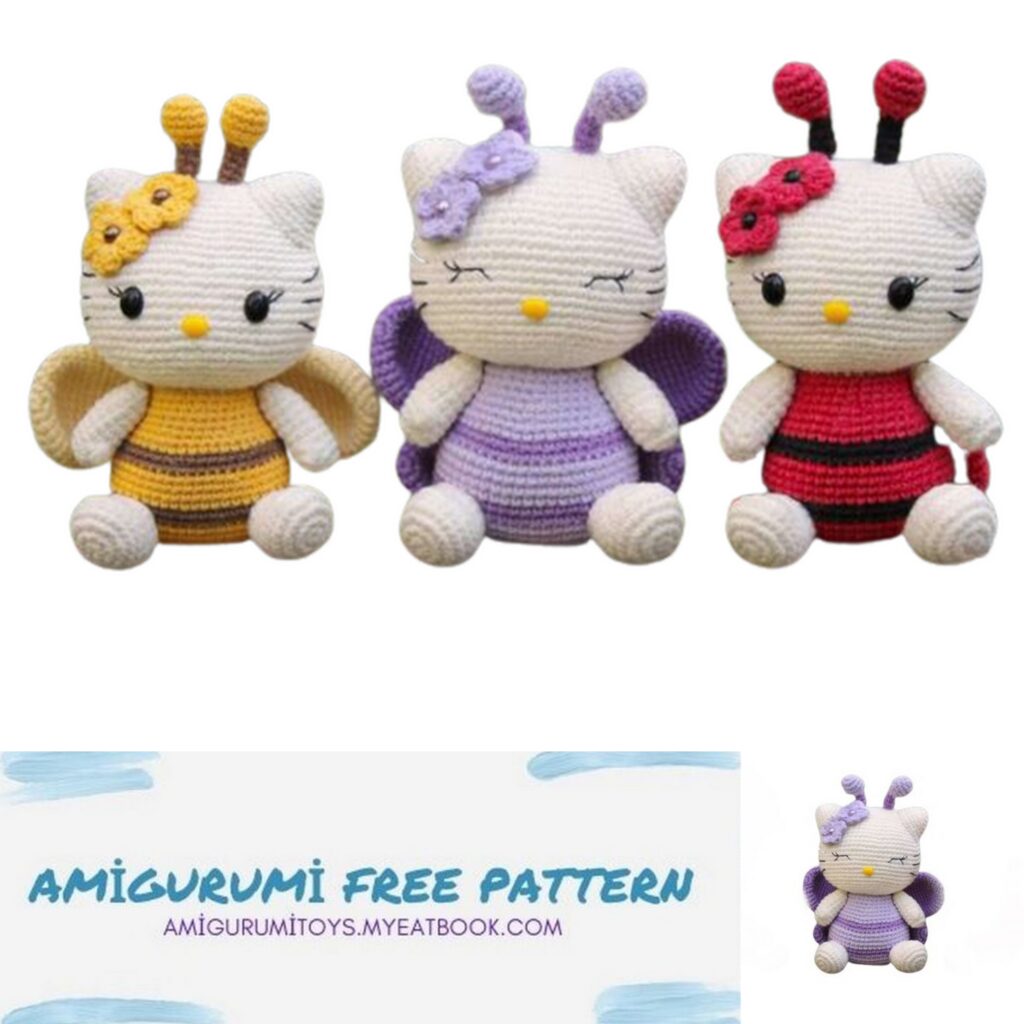
Amigurumi Hello Kitty Free Pattern Assembly and decoration
1. We connect the head and body. Align the last row of the body with the 27th row of the head, which we previously marked with a marker, fix the details with pins. Make sure that the head is straight (orient along the chain from CH, with which we started knitting the head, it should be parallel to the body). Start sewing on the head, alternately grabbing the single crochet of each piece. While sewing, add filler between the neck and head.
2. Fix the ears with pins at the level of 2-10 rows of the head and sew.
3. Glue or embroider a nose in the center of the face between 9 and 10 rows, counting from the bottom of the head. Then decorate the eyes with embroidery or glue the finished ones (it is more convenient to embroider the eyelashes before the eyes are glued). After that, embroider the mustache with black thread – 3 strips on each side. For the convenience of the location of all elements of the face, be guided by the diagrams. You can adjust the position based on your knitting density.
4. Attach the handles to the body with a thread fastener. To do this, you need a long needle and a strong cotton thread in 2 additions (preferably white, a dark thread is used for clarity). Insert the needle at any point on the back and bring it out on the side of the body between 17 and 18 next, leave the tail of medium length. Next, pass the needle from the inside of the handle to the outside (1). Then insert the needle at the same point where the thread comes from (2), and exit from the inside of the handle, but stepping back 2 SC from the first hole (3). After that, pass the needle to the same point on the side of the body where the thread comes from (4), and bring it out symmetrically from the opposite side of the body. (5). Attach the second handle in the same way. For reliable fastening, you can skip the thread for the 2nd time. After both handles are fixed, bring the thread to the back and tie a knot, hide the ends inside the part. Amigurumi Hello Kitty Free
5. Sew the antennae to the top of the head. Amigurumi Hello Kitty Free
6. Sew the flowers on the bottom of one of the ears, leaving the petals free. The middle can be additionally decorated with beads.
7. Fix the legs at the level of 3-7 rows of the body at a distance of 9 SC from each other. The location of the legs may vary slightly, choose it so that the toy sits confidently. Sew on the legs, try to keep their round outline.
8. Sew the wings to the back of the toy. They can be placed raised or folded, depending on the suit. If the wings dangle a lot, secure them with additional stitches.
9. Fix the tail at the level of 5-8 rows of the body and sew. The tail will also serve as an additional support for the toy when sitting.
Amigurumi Hello Kitty Free


